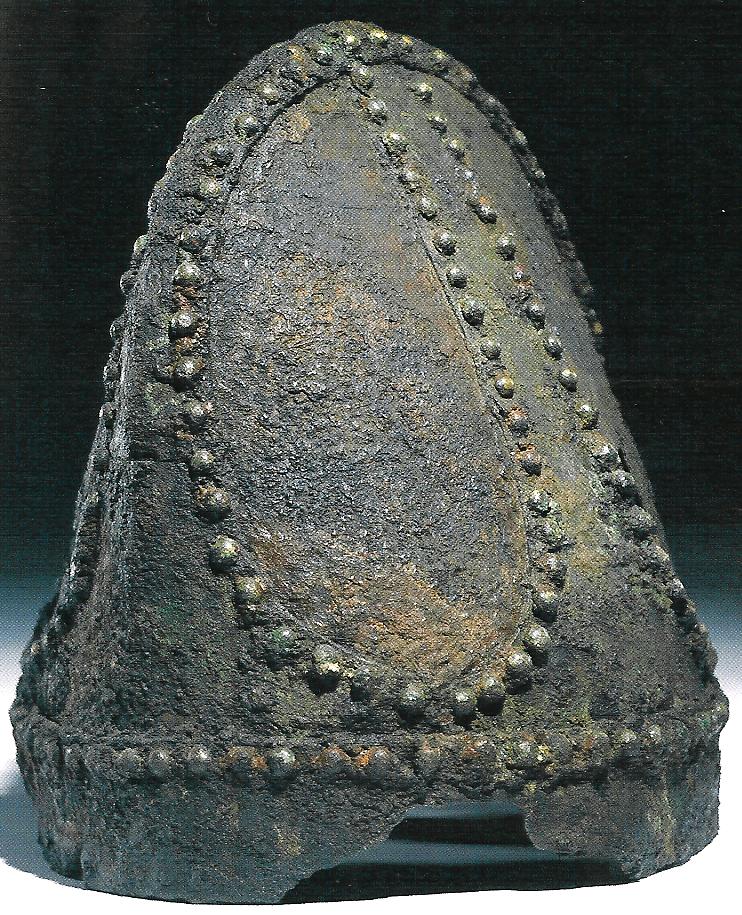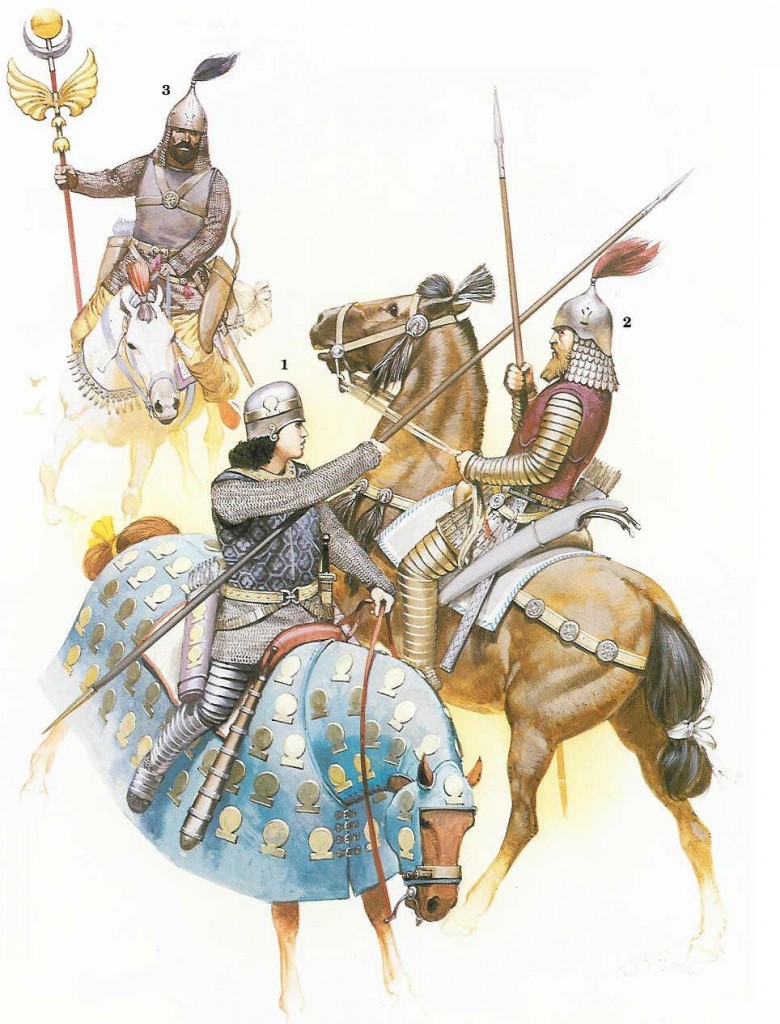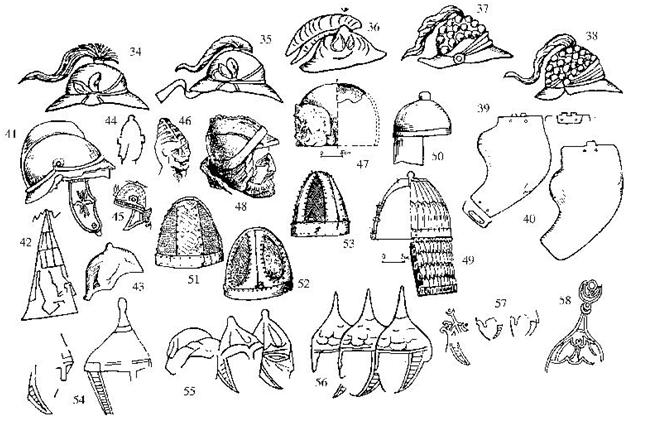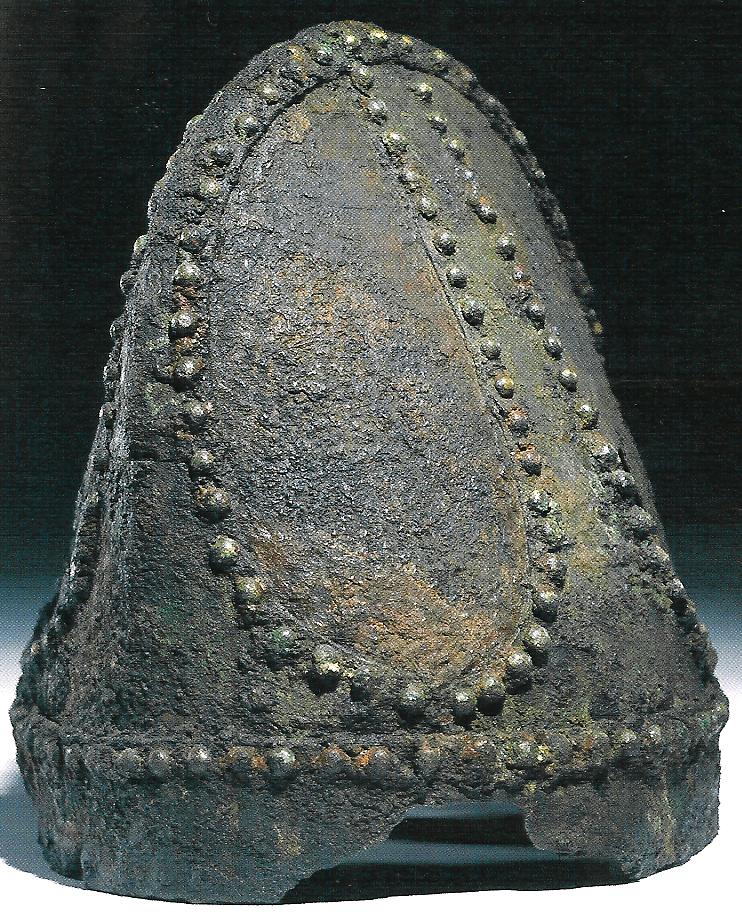The posting below highlights Professor B. A. Litvinsky’s discussion of Partho-Sassanian helmets in an article on pre-Islamic helmets in the Encyclopedia Iranica on December 15, 2003.
The version printed below is different from that which appeared in the Encyclopedia Iranica in that (excepting the drawing panel entitled “Figures 34-58“) it has embedded two paintings and a photo produced in textbooks published by Osprey Publishing. All descriptions under the paintings and photo (excepting the drawing panel entitled “Figures 34-58) are from Kaveh Farrokh’’s lectures at the University of British Columbia’s Continuing Studies Division and Stanford University’s WAIS 2006 Critical World Problems Conference Presentations on July 30-31, 2006
===================================================================
Figures 34-58. Pre-Islamic helmets, 2nd century B.C.E.–7th century C.E. 34. Archebius; 35. 36. Helmet of the Greco-Bactrian king Eucratidus I, on a bronze medallion from the Temple of the Oxus. Antialcidas; 37. Menander. 38. Antimachus. 39-40. Bronze cheek-plates of Hellensitic helmets, from the Temple of the Oxus. 41. Parthian helmet of a clay sculpture, from Old Nisa. 42. Parthian helmet, represented on Ardašir I’s rock-relief at Firuzābād. 43. Parthian helmet, graffito from Dura-Europos. 44. Kushan helmet depicted on the coin of Kujula Kadphises. 45. Kushan helmet on the coin of Huvişka. 46. Kushan helmet, terrakota from Kitab (Kashka-Darĭa One of the Khalchayan sculptures shows an egg-shaped helmet with a low visor projecting forward and a horizontal welt running along the edge of the bowl. Remains of a Kushan helmet made of narrow vertical plates of iron were found in Charsada (Čārsada). The helmet was a standard item in Sasanian armor (Ṭabari, tr. Nöldeke, Geschichte der Perser, pp. 248-49). Finds of early Sasanian helmets include one from Dura-Europos consisting of two halves riveted to two bars and provided with a pointed apex; a mail piece was attached to its lower edge. Many figures represented on Sasanian rock reliefs of the 3rd-4th centuries C.E. wear hemispherical helmets with neckpieces and bindings along the base. On Naqš-e Rostam No. 5, the cap is ornamented and has a knob on the top, while a mail piece is attached to the lower edge (Herrmann, 1977, p. 7, Pls. 1-3). Sassanian Spangenhelm Helmet recovered from Nineveh in modern-day Iraq which would have been a part of Sassanian Enpire (224-651 AD) at the time. The Spangenhelm helmet was constructed by fastening metal plates together by rivets (Picture Source: Farrokh, K., Shadows in the Desert: Ancient Persia at War, Osprey Publishing, pp.223). The greater ayvān of Ṭāq-e Bostān attributed to Ḵosrow II (591-628) shows a different kind of helmet, namely the “segmented” or “‘four-spanged helmet” [spangen helmet] (Fukai and Horiuchi, 1972, Pl. 36; Fukai et al., 1984, pp. 69-70); several helmets of this type are known. These are egg-shaped, made of four vertical iron segments fastened below with a horizontal bronze rim, from which come wide bronze bands crossing at the top. To these bands the iron segments are riveted; the latter are covered with thin, silver leaves for ornamentation. The horizontal rim has holes in its lower part through which a piece of chain mail extending from the shoulders was attached to the helmet (Granicsay, 1948-49, pp. 272-81; Harper, 1978, pp. 89-90, fig. 31; Overlaet, 1982, pp. 193-96, Pls. I-V). Sassanian knight at the time of Shapur II (309–379) engaging Roman troops invading Iran in 333 AD. Note the Spangenhelm helmet and suit of mail covering arms and torso. This knight resembles early Sassanian warriors in which he sports a decorative vest and a medallion strap on his chest; he also dons a Spangenhelm helmet. He has lost his lance in an earlier assault and is now thrusting his heavy broadsword using the Sassanian grip (known in the west as the ‘Italian’ grip) in the forward position for maximum penetration effect. The sword handle is based on that depicted for one of Shapur I’s swords (British Museum B.M.124091); the sheath is based on the Bishapur depictions. His sword tactic is meant for shock and short engagements; he will then retire and discharge missiles. The bow and missiles in the left hand will be deployed as the knight redeploys at least 20 meters away. The quiver is modelled on that of King Pirooz (New York Metropolitan Museum Inv.34.33) (Picture Source: Farrokh, K., Elite Sassanian Cavalry-اسواران ساسانی-, Osprey Publishing, 2005, Plate D, pp.61) . For a detailed discussion about the origin and typology of Sasanian helmets, see von Gall, 1990, pp. 69-72. Monumental art of Central Asia indicates that in that region several other types of helmets were used in the 6th-7th centuries. The most common was a sphero-conical helmet, which was hemispheroid in its lower half but gradually turned into a cone towards the top and was surmounted with a finial ornament. The rim was decorated with festoons. Often it was provided with a narrow bar protecting the nose and with cheekpieces. A piece of chain mail attached to the helmet covered the neck, shoulders, and almost the whole face except the eyes. Such helmets were most often constructed of metal plates, although there were also some made of multiple scales mounted on leather background (Shishkin, 1963, p. 163, Pl. XVII; Belenitskiĭ, 1973, Pls. 8, 9, 12, 21; Raspopova, 1980, p. 84, figs. 57-59). Bibliography: V. I. Abaev, Istoriko-etimologicheskiĭ slovar’ osetinskogo yazyka (Historical-etymological dictionary of Ossetic), IV, St. Petersburg, 1989. A. M. Belenitskiĭ, Monumental’noe iskusstvo Pendzhikenta: Zhivopis’. Skul’ptura (Monumental art of Penjikent: painting. sculpture), Moscow, 1973. St. Bittner, Tracht und Bewaffung das persischen Heeres zur Zeit Achaemeniden, 2nd ed., Munich, 1985. A. D. H. Bivar, “Cavalry Equipment and Tactics on the Euphrates Frontier,” Dumbarton Oaks Papers 26, 1972, pp. 273-307. W. Brandenstein and M. Mayrhofer, Handbuch des Altpersischen, Wiesbaden, 1964. O. M. Dalton, The Treasure of the Oxus, 3rd ed., London, 1964. R. E. V. Chernenko, Skifskiĭ dospekh (Scythian armor),Kiev, 1968. R. Du Mesnil du Buisson, “The Persian Mines,” in The Excavation at Dura-Europos. Preliminary Report. Sixth. Season of Work, New Haven, 1936. Sh. Fukai and K. Horiuchi, Taq-i Bustan II. Plates, Tokyo, 1972. E. Ebeling. “Die Rüstung eines babylonischen Panzerreiters nach einem Vertrage aus der Zeit Darius I,” Zeitschrift für Assyrologie und vorderasiatischen Archäologie, N.F. Bd. 16 (56), 1952, pp. 203-13. Sh. Fukai et al., Taq-i Bustan IV, Tokyo, 1984. R. Ghirshman, Iran. Parthians and Sassanians, London, 1962. M. V. Gorelik, “Zashchitnoe vooruzhenie persov i mid-yan achemenidskogo vremeni” (Persian and Median armor in the Achaemenid period), VDI,1982, 3, pp. 90-106. Idem, “Kushanskiĭ dospekh” (Kushan armor), in G. M. Bongard-Levin ed., Drevnyaya India. Istoriko-kul’turnye svyazi, Moscow, 1982. S. V. Grancsay, “A Sasanian Chieftain’s Helmet,” The Metropolitan Museum of Art Bulletin, April 1963, pp. 253-62. P. O. Harper, The Royal Hunter. Art of the Sasanian Empire, New York, 1978. G. Hermnann, Naqsh-i Rustam 5 and 8. Sasanian Reliefs Attributed to Hormizd II and Narseh (Iranische Denkmäler. Lieferung 8. Reihe II: Iranische Felsreliefs D), Berlin, 1977. A. Invernizzi, Sculpture di metallo da Nisa. Cultura greca e cultura iranica in Partia (Acta Iranica, ser. 3, vol. 21), Lovanii, 1999. S. James, “Evidence from Dura Europos for the Origin of Late Roman Helmets,” Syria 63, 1986, pp. 107-34. B. A. Litvinsky, “History of the Helmet in Bactriana,” Information Bulletin of the International Association of the Cultures of Central Asia No. 22, Moscow, 2000. Idem, Khram Oksa v Baktrii (Yuzhnyĭ Tadzhikistan), Tom. 2. Baktriĭskoe vooruzhenie v drevnevostochnom i grecheskom kontekste (The temple of the Oxus in Bactria [South Tadzhikistan]. Bactrian arms and armor in the ancient Eastern context), Moscow, 2001, pp. 364-81 (with detailed bibliography). B. Litvinsky and I. V. P’yankov, “Voennoe dele y narodov Sredneĭ Azii v VI- IV vv. do n. e. (Warfare of the peoples of Central Asia in the 6th–4th centuries B.C.E.),” VDI , 1966, 3, pp. 36-52. W. Malandra, “A Glossary of Terms for Weapons and Armor in Old Iranian,” IIJ 15/4, 1973, pp. 264-89. A. Mallwitz and H.-V. Herrmann, eds., Die Funde aus Olympia, Athens, 1980. O. W. Muscarella, The Bronze and Iron. Ancient Near Eastern Artefacts in the Metropolitan Museum of Art, New York, 1988. B. J. Overlaet, “Contribution to Sasanian Armament in Connection with a Decorated Helmet,” Iranica Antiqua 17, 1982, pp. 189-206. V. A. Raspopova, Metallicheskie izdeliya ran-nesrednevekovogo Sogda (Metal artifacts in early medieval Sogdiana), St. Petersburg, 1980. V. A. Shish-kin, Varakhsha, Moscow, 1963. M. Rostovtzeff, “Pictures Graffiti,” in The Excavations at Dura-Europos. Preliminary Report. Fourth Season of Work, New Haven, 1933. A. Tafazzoli, “A List of Terms for Weapons and Armour in Western Middle Iranian,” Silk Road Art and Archeology, 3, 1993/94, pp. 187-98. H. von Gall, Das Reiterkampfbild in der iranischen und iranisch-beeinflussten Kunst parthischer und sasanidischer Zeit (Teheranischer Forschungen, Bd. VI), Berlin, 1990.








